Buying a guitar amp doesn’t need to be a bank-breaking endeavor. In fact, today’s market offers an incredible range of Good Inexpensive Guitar Amps that deliver fantastic sound and features without emptying your wallet. Thanks to advancements in amplifier technology, particularly modeling, you can get more value than ever before for your money.
When you’re on the hunt for a new amp, the first thing to consider is how you plan to use it. For home practice, the options are virtually limitless – just steer clear of excessively loud tube amps if you want to keep the peace. However, if you’re aiming to play gigs, you’ll need to think more carefully. Your amp will need enough power to hold its own against a drummer, a vocalist through the PA, and possibly another guitarist.
To simplify your search, we’ve organized our favorite guitar amps under $500 based on different use cases. Whether you’re just starting out and learning your first chords at home or you’re ready to hit the stage and play live shows, we’ve got a good inexpensive guitar amp that will meet your needs at a surprisingly affordable price.
If you’re looking to deepen your understanding of guitar amps before making a purchase, we’ve included a comprehensive FAQ section addressing many common questions. To discover the best good inexpensive guitar amps available for under $500 right now, just keep reading…
Our Top Picks
[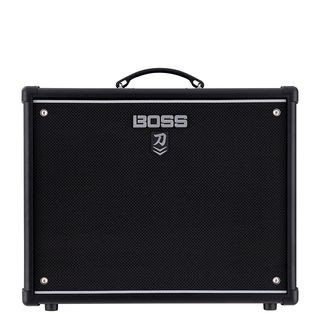 Boss Katana-100 MKii](Best overall)
Boss Katana-100 MKii](Best overall)
- Boss Katana-100 Gen 3
The latest generation of Boss’s hugely popular Katana amps expands upon its already solid foundation by incorporating an additional amp model. Each of the amp models has been refined, providing even more realistic tube-like tones.
[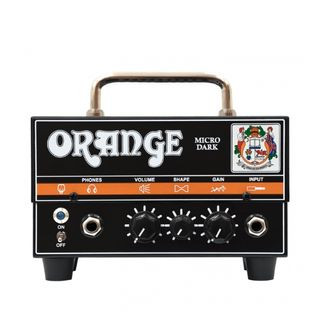 An Orange Micro Dark guitar tube head](Best head)
An Orange Micro Dark guitar tube head](Best head)
- Orange Micro Dark
Possibly the smallest genuine amplifier capable of fitting inside a guitar case, the Micro Dark is nonetheless packed with features. These include volume, gain, and shape controls, a 1/4-inch headphone output, a speaker output (minimum 8-ohm load), and an effects loop.
[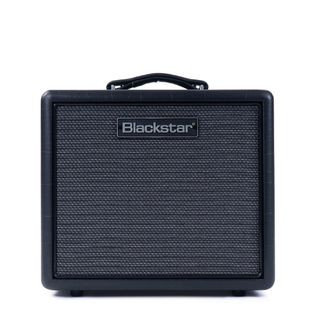 A Blackstar HT-1R MKIII tube amp](Best tube)
A Blackstar HT-1R MKIII tube amp](Best tube)
- Blackstar HT-1R MKIII
Choices for good inexpensive tube amps might be limited, but if authentic tube tone is a must-have, the Blackstar HT-1R is our top recommendation. It falls just under the $500 threshold and is also considerate to neighbors thanks to its silent recording output.
Best Good Inexpensive Amp Overall
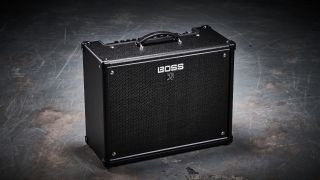 A Boss Katana 100 Gen 3 guitar amp on a stone floor
A Boss Katana 100 Gen 3 guitar amp on a stone floor
(Image credit: Future)
1. Boss Katana-100 Gen 3
The best good inexpensive guitar amp under $500 you can buy today.
Our expert review:
Specifications
Type: Solid-state combo
Output: 100W
Number of channels: 6
Effects: 15
Weight: 14.8kg
Reasons to buy
- Exceptionally versatile feature set
- Top-notch, inspiring effects
- Convincing, tube-like tones
Reasons to avoid
- Might be overly complex for players seeking simplicity
- Bluetooth functionality requires an additional purchase
At a glance
✅ Buy if you want the most reliable amp: For us, the Boss Katana is not just an outstanding sounding practice amp but also one of the most dependable options available. It’s versatile enough for any genre and excels for both practice and small gigs.
❌ Avoid if you don’t need effects: This amp is loaded with the renowned effects Boss is famous for. If effects aren’t a priority for you, exploring other options might be worthwhile.
Even without considering their attractive price points, Boss’s Katana modeling amps have established themselves as some of the best guitar amps available, and the latest Gen 3 edition only strengthens this reputation.
This 100W solid-state model is ready for the stage and now features six amp characters (Clean, Crunch, Pushed, Lead, Brown, and Acoustic), each with variations. Being a Boss amp, it also incorporates 60 of their most celebrated stompboxes into a single amplifier, providing a vast array of tonal possibilities.
Our tests highlighted the tonal control as a key strength of the Katana, featuring adjustable cabinet resonance options, Power Control, and easily recordable mic’d cabinet-emulated outputs. It’s important to note that the listed prices are for the 2×12″ combo version, but a 1×12″ version is also available at a slightly lower cost. This amp stands out as a top pick for a good inexpensive guitar amp that offers professional features at a budget-friendly price.
Best Good Inexpensive Guitar Head
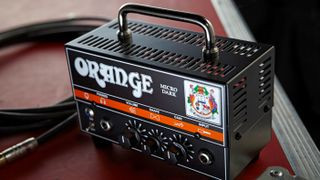 An Orange Micro Dark tube guitar head
An Orange Micro Dark tube guitar head
(Image credit: Future)
2. Orange Micro Dark
A brilliant good inexpensive guitar head.
Our expert review:
Specifications
Type: Tube micro head
Output: 20W
Number of channels: 1
Tubes: 1x 12AX7 tube
Weight: 1.72 lbs
Reasons to buy
- Delivers a massive amount of gain
- Includes an effects loop for integrating outboard gear
- Incredibly lightweight and portable
Reasons to avoid
- More suitable for practice than gigging in larger venues
At a glance
✅ Buy if you want a great budget guitar head: The Orange Micro Dark provides a wealth of tone in a compact package that is surprisingly affordable.
❌ Avoid if you don’t have a cab: This head unit requires a separate guitar cabinet to operate, so you’ll need to factor that into your setup.
The incredibly small Orange Micro Dark features a preamp powered by a single 12AX7 tube and a 20-watt solid-state power amplifier. Despite its size, it delivers impressively loud volumes, characterized by a robust bass response and harmonically rich overdrive. For a good inexpensive guitar amp head, it punches well above its weight.
The shape control offers a wide range of tones by sweeping through a broad midrange sweet spot, allowing for enhancement of both treble and bass frequencies as needed.
The effects loop enables guitarists to incorporate studio-quality multi-effects units, reverb, delay, or modulation pedals between the preamp and power amp stages. This results in professional-grade tones with minimal noise and impressive clarity, sounding particularly expansive when recorded.
We found the Micro Dark to be a surprisingly versatile and potent “secret weapon,” especially for metal guitarists who favor highly saturated distortion but want to avoid the burden of transporting heavy equipment. It’s a fantastic choice for a good inexpensive guitar amp that doesn’t compromise on tone.
Watch the Orange Micro Dark review video
Best Good Inexpensive Tube Amp
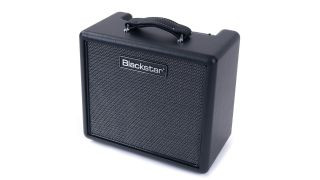 A Blackstar HT-1R MK III tube combo amp
A Blackstar HT-1R MK III tube combo amp
(Image credit: Blackstar)
3. Blackstar HT-1R MK III
One watt of pure, heavenly valve-driven tone. A true little star…
Our expert review:
Specifications
Type: Valve combo
Output: 1W RMS
Number of channels: 2
Speaker: 8”
Effects: Reverb
Weight: 12.3lbs/5.6kg
Reasons to buy
- Authentic valve tones at an accessible price
- Visually appealing design
- USB recording output for direct recording
Reasons to avoid
- Lacks the extensive features and versatility of solid-state amps
At a glance
✅ Buy if you want an affordable tube amp you can use at home: If you must have genuine tube tone, the HT-1R MK III is an excellent choice. It’s equipped with useful features and, most importantly, delivers great sound quality.
❌ Avoid if you’re frequently moving it around: The rear panel jacks are positioned awkwardly, which can be inconvenient if you need to transport it regularly between practice and rehearsal.
We were impressed with the charming HT-1R MK II, and now the MK III version offers even further refinement. Despite its unassuming appearance, it packs a serious punch, ready to unleash some real grit. For those seeking a good inexpensive tube amp, this is a prime contender.
We all know that a tube amp truly shines when cranked, but that’s not always practical, especially when considering your neighbors.
The HT-1R addresses this perfectly with its one-watt output. It can still get surprisingly loud but doesn’t have the sheer power to disturb the neighborhood. What it does offer is the potential for beautiful overdriven tones at lower, more manageable volumes.
It features two channels: an overdrive channel that can be dialed in for anything from articulate crunch to high-gain distortion, and a clean channel for sparkling American tones or chimey British sounds. Both channels are remarkably responsive to dynamic playing.
The HT-1R MK III is designed for home use but is equally capable as a studio companion. Recording big, full, high-gain tones might seem like a job for a powerful combo or stack, but this small amp can achieve it with just as much character and considerably less hassle. You can choose to mic up the Blackstar or take a direct feed via USB.
If you crave the sound of a real valve power amp in a home setting, the HT-1R MK III is definitely worth considering. A head version is also available for an even smaller footprint, ideal for USB recording or connecting to a cabinet. It’s a top choice for a good inexpensive guitar amp that delivers genuine tube warmth.
Read our full Blackstar HT-1R MKIII review
Best Good Inexpensive Amp for Gigging
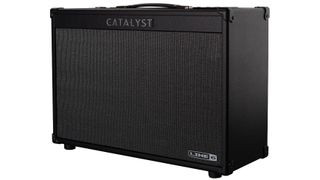 A Line 6 Catalyst 200 2×12” guitar amp
A Line 6 Catalyst 200 2×12” guitar amp
(Image credit: Vox)
4. Line 6 Catalyst 200
A brilliant combo that’s powerful enough for gigging and a good inexpensive guitar amp for stage use.
Our expert review:
Specifications
Type: 2×12 modeling combo
Output: 200W
Presets: 12
Weight: 18.9kg
Reasons to buy
- Powerful enough for any performance scenario
- Integrated 4-channel audio interface
- High-quality Helix effects onboard
Reasons to avoid
- Footswitch is sold separately
- Limited to two simultaneous effects
At a glance
✅ Buy if you want an amp powerful enough to gig: With 200 Watts of power, this amp is more than capable of handling virtually any gig situation.
❌ Avoid if you use lots of effects: While the effects are high quality, you are limited to using only two at a time, with one slot always reserved for reverb.
Line 6 has been a mainstay in the budget amp market for many years, with their Spider range being well-known in the guitar community. While the Spider range continues to evolve and improve, the Catalyst line offers a slightly different approach. Instead of overwhelming users with an excessive number of options, the Catalyst simplifies things by providing just 6 carefully designed original amp models, reducing the potential for choice paralysis. This makes it a very user-friendly good inexpensive guitar amp for gigging musicians.
While focusing on simplicity, the Catalyst doesn’t compromise on features, incorporating professional-level effects derived from their HX range. It also includes valuable additions such as a 4-channel USB interface, making it a strong competitor to the Boss Katana series.
The Catalyst range starts at 60W – which is already quite powerful – but we’ve highlighted the massive 200W version here. This amp can comfortably handle almost any gig venue, making it an excellent choice for musicians seeking their first gigging amplifier or a reliable backup. With built-in power attenuation down to 0.5W, it’s also versatile enough for home practice. For a good inexpensive guitar amp that can transition from bedroom to stage, the Catalyst 200 is a strong contender.
Best Good Inexpensive Amp for Practice
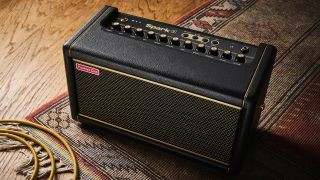 A Positive Grid Spark 2 practice amp on a rug
A Positive Grid Spark 2 practice amp on a rug
(Image credit: Future)
5. Positive Grid Spark 2
A brilliant practice amp for home use and a good inexpensive guitar amp for honing your skills.
Our expert review:
Specifications
Type: 2×4” modeling combo
Output: 50W
Presets: 10,000+ with Spark app
Weight: 5.2kg
Reasons to buy
- Exceptionally good sounds for practice
- Now includes a built-in looper!
- Incredible selection of effects
- Innovative AI tone creator
Reasons to avoid
- Looper footswitch is sold separately
- App is necessary to unlock its full potential
At a glance
✅ Buy if you want to upgrade your practice regime: Packed with tones and tools designed to enhance your guitar playing, Spark 2 is the ultimate practice amp for any guitarist and offers unbelievable value for money.
❌ Avoid if you’re planning on gigging: While it sounds surprisingly full, the PG Spark 2 on its own is not ideally suited for gigging due to its reliance on the app. However, the Spark Cab can be added for extra volume if needed.
Positive Grid’s Spark 40 made a significant impact on the guitar world upon its release in 2020. A considerable amount of time has passed since then, and guitarists have been eager for improvements to this popular desktop amp. Enter the Positive Grid Spark 2, a truly good inexpensive guitar amp for practice.
Addressing almost every point of feedback from users of the original Spark, the Spark 2 is a remarkable upgrade. More of an evolution than a revolution, it adds a looper, improved connectivity, and enhanced app functionality. Crucially, the tones are even better, thanks to improved speakers and a slight power increase.
It excels in sound quality across virtually any genre, and the sheer variety of amps and effects available ensures you’ll never lack options. The integrated looper functions exceptionally well, especially with the optional footswitch. It also features an innovative AI tone generator, enabling you to create custom sounds to your liking. Overall, it’s a superb good inexpensive guitar amp focused on practice and learning.
Read our full Positive Grid Spark 2 review
Best Good Inexpensive Solid State Amp
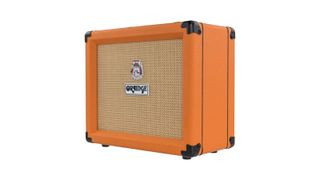 An Orange Crush 20 guitar amp
An Orange Crush 20 guitar amp
(Image credit: Orange)
6. Orange Crush 20
No-nonsense solid-state tones, a reliable and good inexpensive guitar amp.
Our expert review:
Specifications
Type: Solid-state combo
Output: 20W
Number of channels: 2
Effects: None
Weight: 7.15kg
Reasons to buy
- Sometimes simplicity is the best approach
- Iconic and visually striking Orange aesthetic
- Headphone output is invaluable for silent practice
Reasons to avoid
- 8” speaker may be limiting for some users
At a glance
✅ Buy if you have your own pedals: Without built-in effects, the Crush 20 focuses on delivering excellent base amp tone. Adding pedals to this amp simply enhances its versatility.
❌ Avoid if you want an all-in-one solution: With only clean and dirty channels, this amp may feel somewhat basic compared to more feature-rich modeling options.
The Orange Crush 20 is a compact yet powerful 1×8” combo, featuring the distinctive Orange look that is both iconic and beloved. Orange’s styling is undeniably a statement, and their tones live up to this reputation. The Crush 20 was a clear choice for inclusion as a good inexpensive solid state amp.
Featuring clean and dirty channels, a three-band EQ, an aux input, and a cabinet-simulated headphone output, the Crush 20 keeps its features streamlined. While it may have fewer bells and whistles than amps like the Katana, the Crush 20 prioritizes simple, great tones above all else – a focus we greatly appreciate.
While the 8” Voice of the World speaker may not be ideal for gigging, it’s more than adequate for home practice and can hold its own against a drummer in rehearsal settings. As a practice amp, there are few better solid-state combos available in this price range. It’s a truly good inexpensive guitar amp for players who value straightforward, quality sound.
Read our full Orange Crush 20 review
Also Consider
 A Yamaha THR10 II Wireless desktop guitar amp
A Yamaha THR10 II Wireless desktop guitar amp
(Image credit: Yamaha)
7. Yamaha THR10 II Wireless
The original desktop amp series – often imitated, rarely matched, and still a good inexpensive guitar amp option.
Our expert review:
Specifications
Type: Solid-state modeling desktop amp
Output: 20W (15W on battery power)
Number of channels: 1
Speaker: 2 x 3.1”
Effects: Chorus, flanger, phaser, tremolo, echo, reverb, compressor, gate
Weight: 7lbs/3.2kg
Reasons to buy
- Visually stunning design
- Sounds even more impressive than it looks
- Feature-rich functionality
- Rechargeable battery for portability
- Wireless capabilities
Reasons to avoid
- Requires the optional G10 transmitter for wireless operation
At a glance
✅ Buy if you want a wireless option: If you want to eliminate cable clutter, this Yamaha option is definitely your best bet.
❌ Avoid if you need more volume: The THR10 II only produces 20 watts of power, so if you need more volume for band practice or performance, you’ll need to consider alternatives.
Yamaha’s toaster-sized THR amps are a delight to both use and listen to. The THR10 II Wireless, positioned just below its top-tier 30-watt sibling, is only slightly too expensive to be included as a good inexpensive guitar amp in the strictest sense, but it’s worth considering for its value.
Despite its THR10 designation, it actually delivers 20 watts of power, which is more than sufficient for home practice. For quieter musical genres like jazz, folk, or country, it might even suffice for band practice. However, for live performance, it would likely need to be mic’d up.
Yamaha designed this amp to excel both visually and sonically in a home environment. Its appearance is, in our opinion, unmatched among desktop amps, complementing virtually any home décor style.
And the sounds? Yamaha’s music division leveraged the brand’s home entertainment expertise to optimize the pair of small 3.1” (8cm) full-range stereo speakers for peak performance. And they deliver – this amp sounds incredible, especially the driven tones, which are particularly impressive for such a compact amp.
You can select from 15 guitar amp models, three bass amp models, three mic models for acoustic/electrics, and flat voicings for other instruments like keyboards. It also includes a generous selection of onboard effects, plus a compressor and noise gate, all accessible via the THR mobile app. Unlike its higher-end counterpart, it lacks line outputs, but it does feature USB connectivity, enabling the THR 10II to function as an audio interface. Additionally, it includes an Aux In and Bluetooth connectivity.
The wireless capability and rechargeable battery are the crowning features. Imagine playing for hours anywhere in your home, completely free from cables. This makes it an exceptionally convenient and good inexpensive guitar amp for home use.
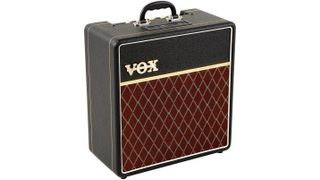 A Vox AC4 C112 guitar amp
A Vox AC4 C112 guitar amp
(Image credit: Vox)
8. Vox AC4 C112
Classic Vox tone in a small package, a good inexpensive guitar amp for vintage sound lovers.
Our expert review:
Specifications
Type: 1×12 Tube Combo
Output: 4W
Presets: N/A
Weight: 10.5kg
Reasons to buy
- Authentic, genuine Vox tones
- 12” speaker delivers a surprisingly full tone
- External speaker output for expansion
Reasons to avoid
- No effects loop for pedal integration
- Lacks a standby switch for tube preservation
- Power switching options would be a welcome addition
At a glance
✅ Buy if you want classic Vox sounds on a budget: This miniature tube amp delivers the iconic Vox twang you expect, just in a more compact format and at a lower price.
❌ Avoid if you want modern features: While it sounds great, this amp is more basic in terms of modern features compared to others in this guide.
The Vox AC4 has been a staple in their lineup since the 1960s, offering a smaller way to access the all-tube tone that Vox is renowned for. The main drawback of the standard AC4 is that the 10” speaker can sometimes sound a bit underwhelming. This is not the case with the AC4 C112, which features an upgraded 12” Celestion speaker, making it a more substantial and good inexpensive guitar amp.
The 4W of tube power is not to be underestimated, and the 12” speaker is significantly more effective at moving air compared to its predecessor. Those extra two inches contribute to a much better low-end response, and when cranked, you can really feel that classic Vox power section in full cry – truly impressive! And if that’s still not enough, there’s an external speaker output, allowing you to drive even more air with an additional cabinet – potentially even suitable for small gigs in this configuration.
The absence of reverb in an amp of this size is not surprising, but an effects loop would have been a useful addition, particularly since this amp can be driven into overdrive quite easily – it doesn’t have a huge amount of headroom – which could muddy up time-based effects placed in front of the amp. However, these are minor points. As a home practice amp, this is an excellent option for Vox enthusiasts and will excel in a recording studio environment. It remains a good inexpensive guitar amp for those seeking that classic British tone.
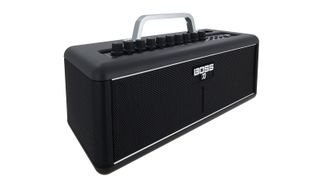 A Boss Katana Air guitar amp
A Boss Katana Air guitar amp
(Image credit: Boss)
9. Boss Katana Air 20/30 Wireless
Desktop amp with stage-quality tones delivered wirelessly, a good inexpensive guitar amp for versatile practice.
Our expert review:
Specifications
Type: Solid-state modeling desktop amp
Output: 30W (20W on battery power)
Number of channels: 1
Speaker: 2 x 3”
Effects: 50
Weight: 4.9lbs/2.2kg
Reasons to buy
- Stylish and attractive design
- Huge variety of tones and effects
- Bundled wireless transmitter for cable-free playing
- Battery power option for portability
- Excellent value compared to competitors
Reasons to avoid
- No built-in rechargeable battery
At a glance
✅ Buy if you want a portable option: The Boss Katana Air 20/30 Wireless offers the same great sounds as the larger Katana amps but in a much more portable format, perfect as a good inexpensive guitar amp for taking anywhere.
❌ Avoid if you don’t need it to be portable: If portability is not a key factor for you, the standard Katana might be a better choice for your needs.
The Katana Air is a desktop amp developed in the same spirit as Yamaha’s pioneering THR series, though with a slightly more traditional guitar amp aesthetic rather than a ‘hi-fi’ look. It’s a dark and appealing design that some may prefer over Yamaha’s somewhat flashier style.
Like Yamaha, Boss (a sister brand to Roland) is highly respected for the quality of its modeling technology, and the Katana Air does not disappoint. Its five amp characters, directly derived from Boss’s Katana stage amplifier line, might seem limited in number, but they cover a full spectrum of tones from pristine cleans to modern ultra-high gain. There’s also an Acoustic Character setting for acoustic/electric guitars and a remarkable 50 effects to shape your sound. And Boss effects are known for their quality.
Like the THR, the Katana Air offers wireless operation for cable-free playing, but unlike the Yamaha, the transmitter is included with the amp, which represents significant cost savings. However, while the Katana Air can run on battery power, it requires standard AA batteries as it does not have a built-in rechargeable battery.
Bluetooth is included for streaming music from other devices, and the Boss Tone Studio smartphone app simplifies configuration, eliminating the need to constantly adjust physical controls.
The Katana Air also features a phones/recording output with cabinet simulation for silent practice or recording. You can even adjust the microphone position on the cabinet simulation using the phone app, adding a level of detail usually found in more expensive amps. It’s a well-rounded and good inexpensive guitar amp for modern guitarists.
Read our full Boss Katana Air review
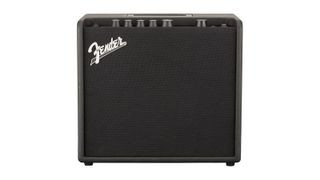 A Fender Mustang LT25 guitar amp
A Fender Mustang LT25 guitar amp
(Image credit: Fender)
10. Fender Mustang LT25
A great option for amp modeling on a budget, the Fender Mustang LT25 is a good inexpensive guitar amp for beginners and beyond.
Our expert review:
Specifications
Type: Digital modeling combo
Output: 25W
Number of channels: 20 amp models
Effects: 25
Weight: 6.7kg
Reasons to buy
- Extremely easy to operate, even for beginners
- Wide range of tones available
- Highly portable and lightweight
Reasons to avoid
- Other similarly priced amps offer a broader feature set
At a glance
✅ Buy if you want a modern amp that’s easy to use: The LT25 is incredibly intuitive to operate, making it perfect even for complete beginners looking for a good inexpensive guitar amp.
❌ Avoid if you don’t want a digital amp: If you’re specifically seeking the warmth and character of tube amps, this digital modeler may not fully satisfy.
Fender is a veteran in the world of modeling amps, and their Mustang series has consistently impressed with its features, sound quality, and user-friendliness. The LT25 is a portable modeling combo featuring an eight-inch speaker, 20 amp models, 25 effects, USB connectivity, and an auxiliary input.
It comes with 30 onboard presets, easily selectable using the large encoder to the right of the amp’s screen. These presets can be easily tweaked, and your customized profiles can be saved.
There are plenty of Fender’s signature smooth, bright, and clean sounds available, but we were also impressed with the substantial high-gain emulations it offers.
In terms of effects, you get a comprehensive selection ranging from compression and gates to octave, auto-wah, delays, and reverbs. For beginners or students, at this price point, it’s hard to go wrong. The Fender Mustang LT25 is a reliable and good inexpensive guitar amp that provides a solid foundation for any guitarist.
Read our full Fender Mustang LT25 review
FAQs
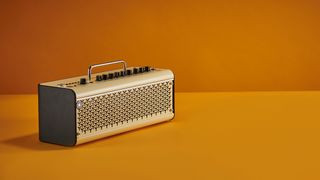 Yamaha THR30II on an orange background
Yamaha THR30II on an orange background
(Image credit: Future)
What to Look for in the Best Good Inexpensive Guitar Amps
With an unprecedented number of options available in the budget guitar market, choosing the right amplifier for your needs can feel overwhelming. Some good inexpensive guitar amps at this price point may not excel in every area but stand out in specific applications, while others are versatile “jacks of all trades,” equally suitable for stage, home, or studio use.
If you’re a beginner, you might benefit more from a versatile amp that can handle various styles and provide a solid platform to explore different aspects of guitar playing. However, if you’re an experienced guitarist with a dedicated live setup but need something more practical for home use or portability, there are many amps specifically designed for these purposes. Finding the good inexpensive guitar amp that suits your specific needs is key.
What Size Amp Do You Need?
Power ratings and amp sizes can initially seem confusing to new guitarists. It might seem counterintuitive that a 5W tube amp can often be louder than a 30W solid-state amp, raising the question, ‘why is this so?’
Generally, it’s challenging to find a tube amplifier under $500 that can comfortably compete with a live band – you’d likely need a minimum of 10-15W for that. Conversely, you can find a 50-100W solid-state amplifier that should be well-suited for stage performance. When considering a good inexpensive guitar amp for gigging, power is a crucial factor.
What Size Speakers Do I Need for My Guitar Amp?
While speaker size isn’t the only factor determining volume, larger speakers—or multiple speakers—generally produce more low-end frequencies, which contributes to the perception of greater volume and fullness.
Some amps offer the option to connect additional speakers via a speaker line output on the rear panel, allowing you to connect to larger cabinets. For example, a small 5W tube amp with a 10” speaker might sound somewhat boxy on its own, but if it has a speaker output (as many do), it could be used to power a 4×12” cabinet. This setup can move significantly more air and feel much louder, though it might still struggle in a full band live mix.
Some desktop amps, like the Yamaha THR series, utilize design principles from hi-fi audio equipment, opting for a combination of smaller speakers. When paired, these speakers create finely nuanced sounds and can produce stereo effects, which sound excellent and offer creative possibilities, all at volumes suitable for home use. For home practice, a good inexpensive guitar amp with smaller speakers is often ideal.
What Tone Should I Look For?
While smaller, lower-wattage tube amplifiers in this price range might be initially overlooked, they excel at delivering authentic, warm tube tone at home-friendly volumes. To achieve this with a typical high-volume valve amp – like a Vox AC30 or Fender Hot Rod Deluxe – you would typically need to purchase a separate attenuator, which reduces the volume output while maintaining the amp’s character. However, many modern tube amps now include built-in power attenuation.
The combined cost of a larger tube amp and a good attenuator can be substantial, potentially exceeding the price of some of our recommended amp picks. In contrast, a smaller tube amp, such as the Blackstar HT1R, can produce classic tube tones even at low volumes. However, if you need exceptionally clean tones, even at moderate volumes, these lower-wattage tube amps might not be ideal as they tend to break up into overdrive relatively quickly. For pristine clean sounds, sub-$500 tube amps might not be the best choice as a good inexpensive guitar amp.
If tube tone isn’t essential, or if volume and versatility are priorities, many of the best good inexpensive guitar amps under $500 are modeling amps, which offer plenty of power and a wide range of sounds. A modeling amp uses carefully designed amp emulations to reproduce the sounds of classic amplifiers, often convincingly mimicking the response of tube amps through their dynamic response to playing, pedal use, and other sophisticated technologies.
Modeling amps are a great option for accessing a variety of sounds, from sparkling cleans to heavy overdrives, all of which can sound natural and authentic. However, it’s important to note that not all modeling amps are created equal. Consult our guide to the best modeling amps to find the most impressive models on the market as a good inexpensive guitar amp.
Solid-state amplifiers are another often-underappreciated option, particularly with the advancements in modeling amps. These amps use transistors instead of tubes or digital modeling circuitry to create their sound. In recent years, solid-state technology has seen a resurgence, and some of the best “cheap” amps available today are solid-state, such as the Orange Crush range. These amps offer a simpler approach compared to modeling amps, providing a straightforward way to achieve great tones.
Transistor technology has advanced significantly, now offering much more nuance than in the past and even closely resembling tube amps in many respects. Historically, solid-state amps were sometimes criticized for their drive tones, which could be an acquired taste, but this has improved greatly, and they now excel at high-gain tones. If you prefer analog simplicity and a wide range of tones, a solid-state transistor amp is definitely worth considering as a good inexpensive guitar amp.
Are Good Inexpensive Guitar Amps Actually Good?
Just a few years ago, our answer to this question might have been different, but the landscape has changed dramatically. The budget guitar amp market has never been better, with even professional players now using affordable guitar amps for home practice or touring. Today, you can find truly good inexpensive guitar amps that meet a wide range of needs.
For under $500/£500, you can now purchase a highly convincing modeling amp that delivers superb tones and features that surpass even high-end amps from just 15 years ago. The Boss Katana range is a prime example: you can get a gig-ready modeling amp with a host of industry-standard effects, advanced editing capabilities via an app, and a built-in audio interface with cabinet simulation… all for under 500 dollars. This level of value is truly remarkable.
Historically, one common drawback of budget amplifiers was their cheap appearance. However, ranges like Yamaha’s THR have completely redefined expectations. These are amps you’d be proud to display in your home, proving that a good inexpensive guitar amp can also be aesthetically pleasing.
Which Brands Make the Best Good Inexpensive Guitar Amps?
While some innovative newcomers have emerged and introduced game-changing products to the budget amp market—Positive Grid, for example—it’s fair to say that established brands have significantly embraced the lower end of the amplifier market in recent years, creating many good inexpensive guitar amp options.
Following the release of the Boss Katana range in 2016, manufacturers such as Marshall, Line 6, and Fender have worked diligently to compete with its offering—it’s that impressive.
This increased competition is fantastic news for guitarists! Almost all of the major brands now produce excellent amplifiers in the sub-$500 price range, and most (if not all) are definitely worth considering when looking for a good inexpensive guitar amp.
Should I Buy a Tube or Solid-State Amp?
For some purists, tube amps are the only “real” amps, and everything else is imitation. It’s true that the sound of a genuine tube amp, whether clean, slightly overdriven, or fully cranked, is uniquely appealing.
However, good tube amps tend to be expensive, which is why you’ll find fewer of them in this guide focused on good inexpensive guitar amps. Those that do fall under $500 are typically small, low-powered, and relatively basic in terms of features. This is perfectly acceptable if you’re a home-based guitarist primarily seeking authentic tube tone at manageable volumes.
In their early days, solid-state amps were excellent for very articulate clean tones—think of the legendary ‘70s Roland Jazz Chorus JC 120—but less ideal for higher gain applications. They were often criticized for sounding harsh or fizzy when overdriven.
However, thanks to modern modeling technology, solid-state amps can now be exceptionally good, especially as good inexpensive guitar amps. Even below the $500 mark, you’ll find many fantastic examples. They also tend to be compact and lower in power, which is ideal for practice or recording amps.
One significant advantage of modeling amps is their versatility. They often come loaded with a wide array of amp emulations, effects, and cabinet simulations, frequently managed through a smartphone app. Despite this, many players still prefer the simpler sound and operation of a basic tube amp.
It’s important to remember that due to their different circuitry, a 5W tube amp can be as loud as, or even louder than, a 30W solid-state amp. In fact, 1W of tube power can be ample for home use, while a 30W solid-state amp might struggle to be heard in a live band setting.
In summary, neither tube nor solid-state is inherently “better”—they are simply different. The best choice depends on your individual needs and preferences when choosing a good inexpensive guitar amp.
What Ins and Outs Do I Need?
If you’re looking for a guitar amp under $500, it’s highly beneficial to choose one equipped with a USB socket. USB connectivity can be invaluable for firmware updates and often handles audio as well as data. This allows you to use your new guitar amp as an audio interface, enabling you to record your playing directly into a DAW or other recording software. This is a great feature to look for in a good inexpensive guitar amp.
Some practice amps may include a phones/rec out jack instead (or in addition to USB). You can also record via this jack, but you’ll need an audio cable and a separate audio interface.
If you’re fortunate, you might even find an amp with proper XLR line outputs, which allow you to connect directly to a PA system for live performances. A small, high-quality practice amp with line outputs can be an incredibly lightweight and convenient stage rig. These features enhance the versatility of a good inexpensive guitar amp.
How We Test
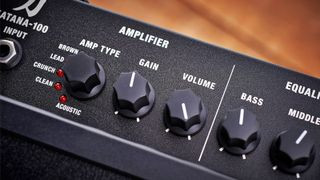 Control panel of Boss Katana 100
Control panel of Boss Katana 100
(Image credit: Future)
Here at Guitar World, we are experts in our field, with extensive experience in playing and testing guitar gear. We are passionate about all things guitar and bass, and we draw on this knowledge and our hands-on experience using products in live, recording, and rehearsal settings when selecting products for our guides.
When determining what we believe are the best good inexpensive guitar amps available today, we combine our personal experience, user reviews, and feedback, and engage in detailed discussions with our editorial colleagues to reach a consensus on the top products in each category.
Our primary goal is to help other guitarists find the right gear for their needs. Therefore, we carefully consider factors ranging from budget and feature set to ease of use and durability to compile lists of what we confidently consider to be the best good inexpensive guitar amps on the market right now.
Read more about our rating system, how we choose the gear we feature, and exactly how we test each product to ensure our recommendations are reliable and helpful in your search for a good inexpensive guitar amp.
Related Buyer’s Guides
You can trust Guitar World. Our expert reviewers spend hours testing and comparing guitar products so you can choose the best for you. Find out more about how we test.
